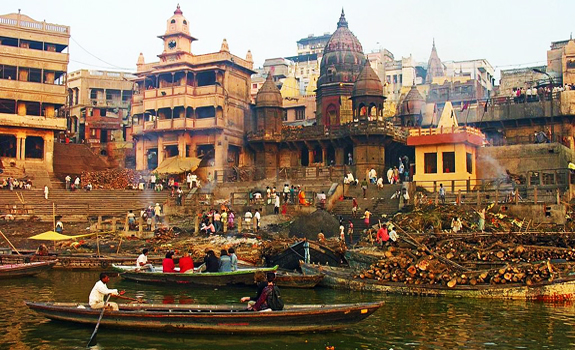By Charles J. Vörösmarty and Claudia Pahl-Wostl
Editor’s Note: The world water crisis demands more than the very models that are now creating national water crises in the developed world. It requires the interdisciplinary participation and expertise “of environmental scientists, social scientists, engineers, policy-makers, and a wide range of stakeholders.” So concluded The Bonn Declaration on Global Water Security adopted at the Global Water System Project Conference on “Water in the Anthropocene” held May 21 – 24 in Bonn Germany. In the latest in our continuing series on water security, Dr. Vörösmarty and Dr. Pahl-Wostl, chief crafters of the Declaration, give us their insights into why we must employ ecologically sustainable water management and avoid the “capital-hungry and energy-intensive solutions” that could further entrap water-starved parts of the planet. This article first appeared in The New York Times. More on our authors at the end of the post. — John Cronin

In Varanasi, some 40,000 cremations are performed each year, most on wood pyres that do not completely consume the body. Along with the remains of these traditional funerals, there are thousands more who cannot afford cremation and whose bodies are simply placed into the Ganges. By Dennis Jarvis from Halifax, Canada [CC-BY-SA-2.0], via Wikimedia Commons
If one incident best highlights the perilous state of the world’s fresh waters, it’s the “pig spill” in China last March. After the slaughter and illegal dumping of a diseased herd, the authorities in Shanghai went fishing for 16,000 bloated carcasses in the Huangpu River, which flows through the city. Hardly the thing you wish to hear about if you use the Huangpu for drinking water.
On the other side of the world, Greg Lyons tends a stretch of the Merrimack River in Massachusetts as a citizen volunteer. One by one, Lyons collects some of the 8 million plastic treatment disks released by a wastewater plant that malfunctioned in March 2011. The disks, two-inch wafers caked with sewage, today serve as a reminder of how massive public waterworks designed to protect the environment can sometimes go haywire. Lyons’s catch by October 2011: 16,000 disks. The situation would have shocked 19th-century Transcendentalists who used the Merrimack to inspire a modern philosophy of humans in kinship with nature.
And then there is the Ganges, arguably the most polluted large river in the world. Each year it carries 16,000 tons of ash from cremated bodies along with a cocktail of sewage and toxic chemicals produced by a dense population and rapidly developing economy. This is no way to treat the goddess Ganga.
It is ironic that many of today’s water problems arise from the very solutions we administer.
A panorama of our conflicted relationship with water is unfolding not only with the sensational fishing expedition for pigs or sewage disks, but with the countless decades of neglect and millions of misguided decisions we make daily regarding this essential resource. This was a chief finding of 350 water experts who recently issued the Bonn Declaration on Global Water Security.
And yet waterborne threats remain under the radar. Exposure to unsafe drinking water and inadequate sanitation results in 3.4 million deaths, mostly poor children, each year from diarrhea, yet this fact never makes the news. Threats also are rising in rich countries like Australia. In January, after drenching rains, residents of Brisbane were asked to restrict water use after the city’s drinking water dwindled to just a six-hour supply. This occurred after the city’s main treatment plant became clogged with sediment washing down from poorly managed land upstream. Across the United States, despite advanced pollution controls, more than 200 million people live within 10 miles of degraded fresh water. Europe is a global hotspot of aquatic biodiversity loss.
It is ironic that many of today’s water problems arise from the very solutions we administer. Proliferation of costly, so-called hard-path engineering, like centralized sewers and large dams, provide undeniable benefits, such as improved hygiene and stable water supply. But they also degrade waters with pollution, obliterate natural flow cycles and block the migration routes of fish and other aquatic life. By throwing concrete, pipes, pumps and chemicals at our water problems, to the tune of a half trillion dollars a year worldwide, we’ve hung a huge technological curtain between the clean water flowing through our faucets and the background array of problems in our rivers, lakes and groundwater. It is no surprise that the public is largely unaware of this or its growing costs.
And virtually unknown to most is the collateral damage to freshwater biodiversity arising from mismanaged watersheds and waterways. Despite overuse and contamination, freshwater ecosystems host a trove of diverse life, almost 10 percent of all known species and one-third of all vertebrates. The 20,000 aquatic species now extinct or imperiled are sending us an important message about our stewardship of fresh water.
Although water has figured prominently in the U.N. development agenda for decades, the world is at a critical juncture as the Rio+20 Sustainable Development Goals take shape over the coming 12 months. In the wings looms a hastily designed and politically motivated post-2015 development agenda. The developing world argues for autonomy in pursuing whatever water-related goals it deems necessary for growth, with a more or less singular focus on the basics of clean drinking water and sanitation. In contrast, the developed world argues for all nations to adopt a broader perspective emphasizing environmental protection, yet is retreating from financial support for the poor to help realize this outcome.
These two perspectives can be reconciled. While it is imperative that we meet the water and sanitation needs of all people, it would be wildly counterproductive if success were achieved at the expense of nature. In a financially strapped world, it is hard to imagine how preservation and sensible use of the rivers, lakes and wetlands would not be a valued component of any long-term development plan. And with the specter of climate change, the very water systems we today abuse, if better managed, could climate-proof society, for example by employing wetlands as natural shock absorbers against floods.
The price tag and environmental damage of poor stewardship and hard-path water management strategies mean that we need to design solutions that deliver basic water services while preserving freshwater ecosystems for future generations.
We are not against sensible deployment of water engineering. But by exporting to poor countries identical versions of the developed world’s model for water management, we risk locking the development agenda into a vicious cycle of capital-hungry and energy-intensive solutions, resource degradation and overuse, and an expanding reliance on costly remediation. We advocate instead a do-no-harm strategy in lieu of emergency care and endless rehabilitation of damaged water systems.
If we fail, we will still have development — but not the sustainable kind.
«« »»
Charles J. Vörösmarty is Professor, Department of Civil Engineering at CUNY and director of CUNY’s Environmental CrossRoads Initiative. He is also a distinguished scientist with NOAA-CREST. He is a founding member and current co-Chair of the Global Water System Project that represents the input of several hundred international scientists under the International Council for Science’s Global Environmental Change Programs. More on Dr. Vörösmarty here.
Claudia Pahl-Wostl is full professor for resources management and director of the Institute for En- vironmental Systems Research (USF) in Osnabrück, Germany. In 2012 the Bode Foundation Water Management Prize was awarded to Prof. Pahl-Wostl for the pioneering interdisciplinary work on “Governance in times of change” and comparative analyses of water governance in large river basins. More on Dr. Pahl-Wostl here.











